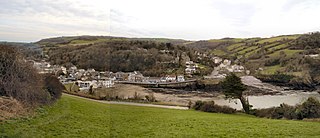
Combe Martin is a village, civil parish and former manor on the North Devon coast about 4 miles (6.4 km) east of Ilfracombe. It is a small seaside resort with a sheltered cove on the northwest edge of the Exmoor National Park.

Maristow House in the parish of Bickleigh, Devon, England, is a large country house set in landscaped parkland, on the River Tavy to the north of Plymouth. It was built in about 1560, rebuilt in the mid-18th century and further remodelled in the early 20th century. Between 1798 and 1938 it was the residence of the Lopes family, Barons Roborough. The house was ruined by fire after World War II, but was restored and converted into apartments in the late 1990s by Kit Martin. It is a grade II* listed building, having been so designated on 29 March 1960.

Haccombe is a village and former civil parish and historic manor, now in the parish of Haccombe with Combe, in the Teignbridge district, in the county of Devon, England. It is situated 2 1/2 miles east of Newton Abbot, in the south of the county. It is possibly the smallest parish in England, and was said in 1810 to be remarkable for containing only two inhabited houses, namely the manor house known as Haccombe House and the parsonage. Haccombe House is a "nondescript Georgian structure" (Pevsner), rebuilt shortly before 1795 by the Carew family on the site of an important mediaeval manor house. In 1881 the parish had a population of 14. On 25 March 1885 the parish was abolished and merged with Combe in Teignhead and to form "Haccombe with Combe".
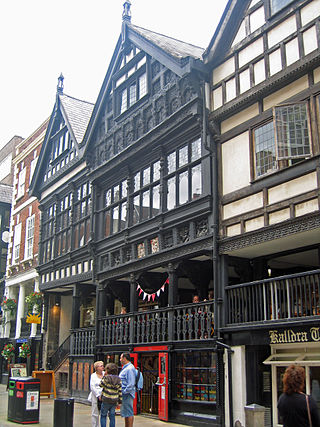
Bishop Lloyd's House is at 41 Watergate Street, and 51/53 Watergate Row, Chester, Cheshire, England. It is recorded in the National Heritage List for England as a designated Grade I listed building. The architectural historian Nikolaus Pevsner considered it to be "perhaps the best" house in Chester.

The Lamb Hotel, now known as Chatterton House, is a former public house in Nantwich, Cheshire, England. It is located on the north side of Hospital Street, at the junction with Church Lane. The present building by Thomas Bower dates from 1861 and is listed at grade II; Nikolaus Pevsner describes it as "decent" and "staid".

The Feathers Hotel is an historic inn in Ludlow, Shropshire. Its imposing half-timbered frontage was constructed in 1619, over an earlier core, for a local lawyer, Rees Jones. John Newman describes the hotel as a "prodigy" of Tudor architecture and it is noted for its Jacobean furnishings. It is a Grade I listed building, listed on 15 April 1954, and is one of approximately 500 listed buildings in Ludlow, but one of its best known.
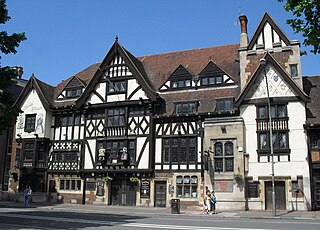
The King and Queen is a pub in the seaside resort of Brighton, part of the city of Brighton and Hove. The present building, a "striking" architectural "pantomime" by the prolific local firm Clayton & Black, dates from the 1930s, but a pub of this name has stood on the site since 1860—making it one of the first developments beyond the boundaries of the ancient village. This 18th-century pub was, in turn, converted from a former farmhouse. Built using materials characteristic of 16th-century Vernacular architecture, the pub is in the Mock Tudor style and has a wide range of extravagant decorative features inside and outside—contrasting with the simple design of the neighbouring offices at 20–22 Marlborough Place, designed a year later. English Heritage has listed the pub at Grade II for its architectural and historical importance.
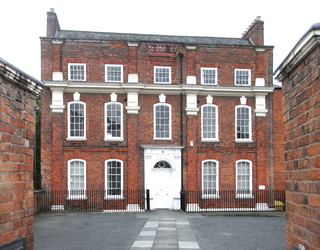
Gotham House is a Grade II* listed early 18th century Georgian merchant's townhouse on Phoenix Lane in the town of Tiverton in Devon, England. An ancient estate named "Gotham" also exists in the parish of Cadeleigh, near Tiverton, now represented by Gotham Farm. It was one of a number of buildings constructed in Tiverton following the disastrous Tiverton fire of 1731. The building was restored in 1966 and currently serves as the base for a firm of solicitors. The house and its forecourt walls and entrance gates became listed on 12 February 1952.

Roborough is a village and civil parish 5.5 mi (8.9 km) from Great Torrington, in Devon, England. Situated topographically on the plateau between the Torridge and Taw Rivers, the parish covers 1,258 ha and contains a population of some 258 parishioners. It is surrounded by a pastoral landscape of rectangular fields, high hedges and scattered farmsteads.

Forde House, now also known as Old Forde House, is a Grade I listed Jacobean former manor house in Newton Abbot, Devon, England. It was built in c. 1610 and is noted for its fine 17th-century wood-carving and plasterwork. Once the manor house of the parish of Wolborough, it is now absorbed into a suburb of Newton Abbot. The south front is clearly visible from the busy Brunel Road which cuts across the house's front lawn.
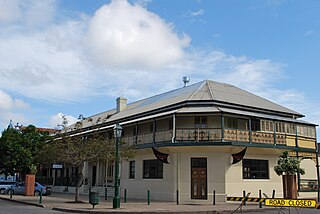
Customs House Hotel is a heritage-listed hotel at 116 Wharf Street, Maryborough, Fraser Coast Region, Queensland, Australia. It was built in 1868. It was added to the Queensland Heritage Register on 21 October 1992.

Palmer House is a grade II* listed Georgian residence built in 1752 in the town of Great Torrington, North Devon, England. It is notable as it retains many original features, including fine ornate plaster ceilings, marble and carved fireplaces, mahogany doors and a fine balustraded staircase.
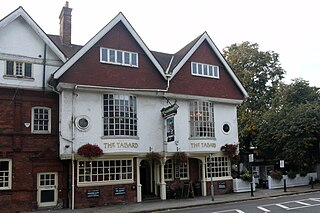
The block of three buildings containing The Tabard public house is a Grade II* listed structure in Chiswick, London. The block, with a row of seven gables in its roof, was designed by Norman Shaw in 1880 as part of the community focus of the Bedford Park garden suburb. The block contains the Bedford Park Stores, once a co-operative, and a house for the manager.
Gayton Hall is a country house in Gayton Farm Road, Gayton, Merseyside, England. It was built in the 17th century and refaced in the following century. The house is constructed in brick with stone dressings, and has an Ionic doorcase. William of Orange stayed in the house in 1690. In the grounds is a dovecote dated 1663. Both the house and the dovecote are recorded in the National Heritage List for England as designated Grade II* listed buildings.
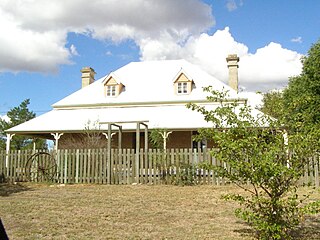
White Swan Inn is a heritage-listed former hotel, now a detached house, at Stevens Road, Swan Creek, Southern Downs Region, Queensland, Australia. It was built c. 1876. It was added to the Queensland Heritage Register on 21 October 1992.

The Criterion Hotel is a heritage-listed hotel at 84 Palmerin Street in Warwick, Queensland, Australia. It was designed by Dornbusch & Connolly and built in 1917 by Connolly & Bell. It was added to the Queensland Heritage Register on 21 October 1992.

Langham Hotel is a heritage-listed hotel at 133 Palmerin Street, Warwick, Southern Downs Region, Queensland, Australia. It was designed by Dornbusch & Connolly and built from 1912 to 1913. It was added to the Queensland Heritage Register on 21 October 1992. It is now home to a registered club, the Condamine Sports Club.

Haccombe with Combe is a civil parish in the Teignbridge local government district of Devon, England. The parish lies immediately to the east of the town of Newton Abbot, and south of the estuary of the River Teign. Across the estuary are the parishes of Kingsteignton and Bishopsteignton. The parish is bordered on the east by Stokeinteignhead and on the south by Coffinswell. Most of the southern boundary of the parish follows the minor ridge road that runs between the suburbs of Milber in Newton Abbot and Barton in Torquay and it bisects the Iron Age hill fort of Milber Down.

The Church of St Peter ad Vincula is the Church of England parish church for the village of Combe Martin in North Devon in the UK. Possibly built on the site of a Saxon church, construction of the present building began in the 13th-century with additions in the 15th-century and later. It has been a Grade I listed building since 1965. The church comes under the Diocese of Exeter. Pevsner describes the church as "One of the best in the neighbourhood." The church is one of only 15 in England dedicated to St Peter ad Vincula, after the basilica of San Pietro in Vincoli in Rome.
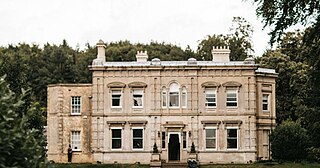
Cleatham Hall is an English country house located near Manton in Lincolnshire, England. The building is of special interest and has a Grade II listing on the National Heritage List for England. The main building was constructed in 1855 but some of it dates back to the 18th and perhaps the 17th century. The Hall was, in its early years, in the ownership of ancestors of Charles Darwin. It is now a boutique hotel and event venue.























